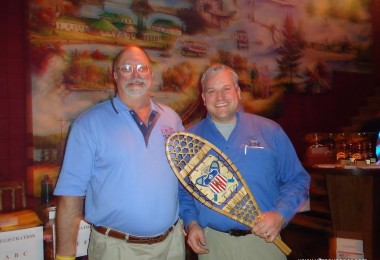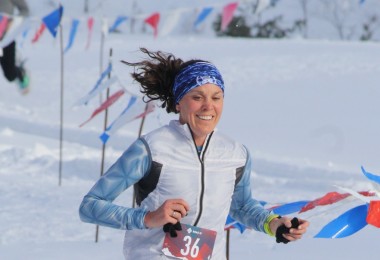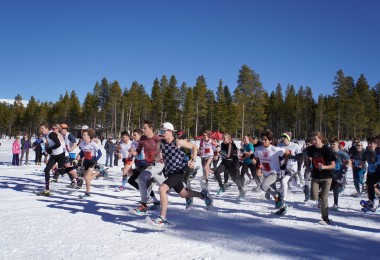The figures milling around Jeffersonville, Vt., early on a crystalline January morning seemed straight out of the Revolutionary War era. People carried old-style muzzleloaders, and walked around on old-fashioned wooden snowshoes. The crowd warded off the subzero cold in animal pelts and bulky 18th-century wool coats and wraps. Not a stitch of polypropylene or GORE-TEX in sight.
The 10th annual Smugglers Notch Primitive Biathlon if nothing else had a sense of history. Unlike the modern equipment, skis and clothing seen in most biathlons, competitors here were required to use rustic single barrel traditional style muzzleloaders with no in-line or optical sights. Old style wooden snowshoes were de rigeur.
Though there were no clothing requirements – organizer Ray Saloomey wants to keep things simple – most of the competitors got into the spirit of the day and dressed in the types of clothing common among 17th, 18th and 19th century New England settlers.
Saloomey, 52, started the biathlon 10 years ago as part of a Jeffersonville area winter carnival. He said he wanted to create an event that’s not the usual run-of-the-mill ski town event. Since then, the idea has caught on and there are now similar biathlons elsewhere in the nation. The same competitors often turn up and several of the primitive biathlons over the course of a winter.
Saturday, the first day of the two-day Jeffersonville event, dawned frigid; it was in the teens below zero. But none of the people in wool capes, buckskin, leather boots, and animal skin hats seemed cold. Competitor Colin Tindall, 31, of Colchester, Vt., said the clothes aren’t meant to last as long as today modern fabrics. But he said he stays plenty warm. Tindall, like many of the competitors, are members of various battle reenactment groups. In the summer, they revisit the Revolutionary War, the French and Indian War and many other long ago battles. What’s nice about the primitive biathlon, many participants said, was the chance to try out old style winter gear.
Nick Salvati, 52, of Livermore, Me., wore unusual snowshoes, large, almost perfect round, with a fine mesh. He said this type of snowshoe was common in the 18th century, way before the likes of Tubbs took over. He prefers the old styles to modern types of snowshoes. He bought the shoes, which are maybe 50 years old, at a garage sale for $10.
“I love them. I’ve always had good luck with them,” Salvati said. “I went on a rabbit hunt with them and got funny looks from the guide.” But, the guide suffered when he broke a binding. Had Salvati broke his own binding, he could have just tied the leather strap back together.
Before setting off onto the course, a few competitors stopped at “the playground” a small area set aside to practice before setting off onto the 2.5- mile course. Few people practiced, choosing instead to set right off into the woods.
One at a time, a few minutes apart, Saloomey sent the competitors off. Soon the air filled with sporadic muzzleloader fire. Some close by, some distant. Less than an hour later, the first competitor emerged from the trees, took three shots at three targets, referred to as gongs, in a field with a sweeping view of Mt. Mansfield. The targets, each about the size of a cup saucer, were 35 to 50 yards away from the competitors. Many competitors were lucky to hit half the nine targets. None hit all nine this year, which is unusual, Saloomey said.
“The difficult nature of it is what makes it fun,” Tindall said. Competitors are scored by the amount of time they take to run the course, with five minutes deducted from the time for each target hit. That means slower but accurate people often come out ahead.
For instance, the final results showed Brian Rowell came in 8th, while David Gardell places 7th. Rowell was 15 minutes faster than Gardell, but Gardell hit eight targets, as opposed to Rowell’s five.
Most participants were in it for the fun. “I have a custom-made gun. It’s just really neat to use a primitive weapon. It’s just fun to hear the gong ring and see it swing, hear the kaboom and see the smoke that goes with it,” said Wendy Butler of New Haven, Vt.
Outside the biathlon course, the event took on a festive mood. Vendors set up a small bazaar in front of the inn. Visitors could buy buffalo hides, buckskin, knives, pelts, anything you want to survive in the 18th century backwoods.
This is where competitors caught their breath and assessed their performance. Kody Spencer, 12, was among the younger competitors. “I was kind of slow in my running and I didn’t get as many hits as I wanted,” he said, vowing to compete again the next day and do better. Spencer said he uses a practice course at his Ascutney, Vt. home about twice a week, but the Jeffersonville course had more hills, so he was out of breath.
The primitive biathlon is a family affair for the Spencers. Kody’s father, Stan Spencer, 43, competed, as did his wife. Daughter Rebeka, 10, ran the course with a muzzleloader to get the feel of the competition, but didn’t shoot at any targets. Stan Spencer said the primitive biathlon, and his larger enthusiasm for the primitive lifestyle is a test, a matter of personal pride, to see if he and others are tough enough to recreate the hardship of 18th century settlers. “You see if you can be as tough and organized as the guys used to be,” he said. “Everyone is so soft now. I want to see if you have the chutzpah to settle this place.”
Butler said the competitors are a close-knit bunch. “You learn a lot from other shooters. The course is beautiful. It’s so pretty in the woods by yourself. Keeping in the traditional spirit, prizes to top finishers included a handmade 18th century backpack, a birch bark basket, a coonskin pelt and a one-year subscription to Muzzleloading and Traditional Living Magazine.





